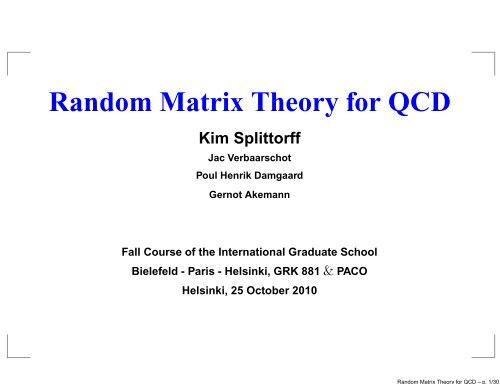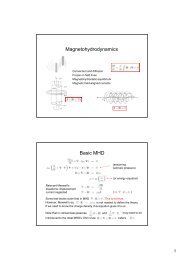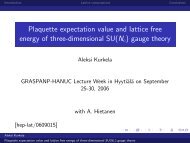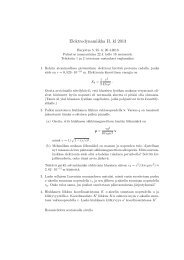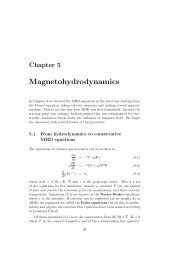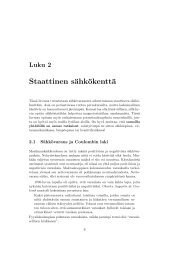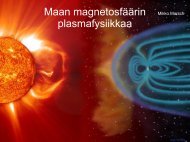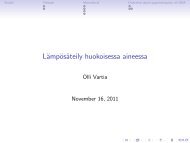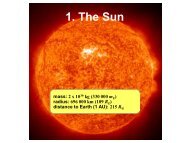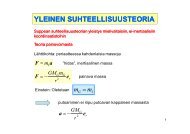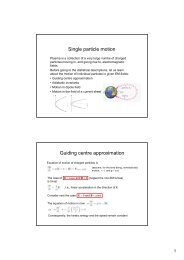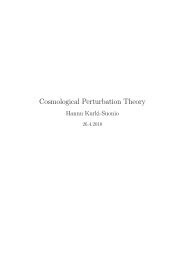Random Matrix Theory for QCD
Random Matrix Theory for QCD
Random Matrix Theory for QCD
You also want an ePaper? Increase the reach of your titles
YUMPU automatically turns print PDFs into web optimized ePapers that Google loves.
<strong>Random</strong> <strong>Matrix</strong> <strong>Theory</strong> <strong>for</strong> <strong>QCD</strong> – p. 1/30<br />
<strong>Random</strong> <strong>Matrix</strong> <strong>Theory</strong> <strong>for</strong> <strong>QCD</strong><br />
Kim Splittorff<br />
Jac Verbaarschot<br />
Poul Henrik Damgaard<br />
Gernot Akemann<br />
Fall Course of the International Graduate School<br />
Bielefeld - Paris - Helsinki, GRK 881 & PACO<br />
Helsinki, 25 October 2010
LECTURE 3: Dirac spectra<br />
<strong>Random</strong> <strong>Matrix</strong> <strong>Theory</strong> <strong>for</strong> <strong>QCD</strong> – p. 2/30
Appetizer !<br />
<strong>Random</strong> <strong>Matrix</strong> <strong>Theory</strong> <strong>for</strong> <strong>QCD</strong> – p. 3/30
<strong>Random</strong> <strong>Matrix</strong> <strong>Theory</strong> <strong>for</strong> <strong>QCD</strong> – p. 4/30<br />
The spectrum of the Dirac operator<br />
0.5<br />
0.4<br />
0.3<br />
ρ S<br />
(ζ)<br />
0.2<br />
0.1<br />
0<br />
0 10 20 30<br />
ζ<br />
Damgaard, Heller, Niclasen, Rummukainen, PLB 495 (2000) 263
<strong>Random</strong> <strong>Matrix</strong> <strong>Theory</strong> <strong>for</strong> <strong>QCD</strong> – p. 5/30<br />
What: Spectrum of the Dirac operator<br />
Why: Spontaneous Breaking of Chiral symmetry<br />
Understand: Finite volume effects<br />
Effects of lattice spacing
<strong>Random</strong> <strong>Matrix</strong> <strong>Theory</strong> <strong>for</strong> <strong>QCD</strong> – p. 5/30<br />
What: Spectrum of the Dirac operator<br />
Why: Spontaneous Breaking of Chiral symmetry<br />
Understand: Finite volume effects<br />
Effects of lattice spacing<br />
Learning Goal: be able to derive the Banks-Casher relation
<strong>Random</strong> <strong>Matrix</strong> <strong>Theory</strong> <strong>for</strong> <strong>QCD</strong> – p. 6/30<br />
The Banks Casher relation<br />
- why the small eigenvalues of the Dirac operator are particularly interesting<br />
Σ ∼ ρ(λ = 0)
<strong>Random</strong> <strong>Matrix</strong> <strong>Theory</strong> <strong>for</strong> <strong>QCD</strong> – p. 6/30<br />
The Banks Casher relation<br />
- why the small eigenvalues of the Dirac operator are particularly interesting<br />
Σ ∼ ρ(λ = 0)<br />
you will derive this relation shortly
<strong>Random</strong> <strong>Matrix</strong> <strong>Theory</strong> <strong>for</strong> <strong>QCD</strong> – p. 7/30<br />
Properties of the <strong>QCD</strong> Dirac operator<br />
Anti-Hermitian<br />
(iD µ γ µ ) † = −iD µ γ µ<br />
Axial-Symmetry<br />
{iD µ γ µ , γ 5 } = 0<br />
No additional symmetries.
<strong>Random</strong> <strong>Matrix</strong> <strong>Theory</strong> <strong>for</strong> <strong>QCD</strong> – p. 8/30<br />
The <strong>QCD</strong> partition function with source<br />
Path integral<br />
Z <strong>QCD</strong> =<br />
Z<br />
dA det(iD µ γ µ + m) N f<br />
e −S YM(A)<br />
U(N f ) × U(N f ) chiral symmetry broken to U(N f ) by the quark mass.
The <strong>QCD</strong> partition function with source<br />
Path integral<br />
Z <strong>QCD</strong> =<br />
Z<br />
dA det(iD µ γ µ + m) N f<br />
e −S YM(A)<br />
U(N f ) × U(N f ) chiral symmetry broken to U(N f ) by the quark mass.<br />
The chRMT partition function<br />
<strong>Matrix</strong> integral<br />
Z ≡<br />
Z<br />
dW det(D(m)) N f<br />
e − N 2 TrW † W<br />
where<br />
D(m) =<br />
0<br />
@ m iW<br />
iW † m<br />
1<br />
A<br />
same explicit symmetry breaking Same effective theory !<br />
Shuryak, Verbaarschot, NPA 560, 306 (1993)<br />
<strong>Random</strong> <strong>Matrix</strong> <strong>Theory</strong> <strong>for</strong> <strong>QCD</strong> – p. 8/30
Mini-Activity:<br />
What can we say about the eigenvalues of iD µ γ µ <br />
<strong>Random</strong> <strong>Matrix</strong> <strong>Theory</strong> <strong>for</strong> <strong>QCD</strong> – p. 9/30
<strong>Random</strong> <strong>Matrix</strong> <strong>Theory</strong> <strong>for</strong> <strong>QCD</strong> – p. 9/30<br />
Mini-Activity:<br />
What can we say about the eigenvalues of iD µ γ µ <br />
1) The eigenvalues must be purely imaginary<br />
2) If iDψ = iλψ then iDγ 5 ψ = −iλγ 5 ψ<br />
Eigenvalues in pairs (iλ, −iλ) unless λ = 0.
Activity: Banks Casher relation<br />
<strong>Random</strong> <strong>Matrix</strong> <strong>Theory</strong> <strong>for</strong> <strong>QCD</strong> – p. 10/30
<strong>Random</strong> <strong>Matrix</strong> <strong>Theory</strong> <strong>for</strong> <strong>QCD</strong> – p. 11/30<br />
Banks Casher<br />
Im(z)<br />
_<br />
< ψ ψ >(m)<br />
X<br />
X<br />
X<br />
X<br />
X<br />
X<br />
Re(z)<br />
_<br />
< ψ ψ ><br />
m<br />
X<br />
X<br />
〈 ¯ψψ〉 = π V ρ(0) Banks Casher NPB 169 (1980) 103
<strong>Random</strong> <strong>Matrix</strong> <strong>Theory</strong> <strong>for</strong> <strong>QCD</strong> – p. 12/30<br />
The spectrum of the Dirac operator<br />
0.45<br />
0.4<br />
0.35<br />
0.3<br />
0.25<br />
0.2<br />
0.15<br />
0.1<br />
0.05<br />
0<br />
0 5 10<br />
How do we read of ρ(λ ∼ 0) <br />
Berg, Bittner, Lombardo, Markum, Pullirsch, Wettig hep-lat/0007008
How do we read of ρ(λ ∼ 0) <br />
Analytic prediction from chRMT<br />
only depends on λΣV<br />
ρ(λ) = λΣV<br />
2 (J 0(λΣV ) 2 + J 1 (λΣV ) 2 )<br />
Verbaarschot Zahed PRL 70 (1993) 3852<br />
<strong>Random</strong> <strong>Matrix</strong> <strong>Theory</strong> <strong>for</strong> <strong>QCD</strong> – p. 13/30
How do we read of ρ(λ ∼ 0) <br />
Analytic prediction from chRMT<br />
ρ(λ) = λΣV<br />
2 (J 0(λΣV ) 2 + J 1 (λΣV ) 2 )<br />
only depends on λΣV<br />
0.45<br />
0.4<br />
0.35<br />
0.3<br />
0.25<br />
0.2<br />
0.15<br />
0.1<br />
0.05<br />
0<br />
0 5 10<br />
Extract Σ from simulation at finite volume !<br />
Verbaarschot Zahed PRL 70 (1993) 3852<br />
<strong>Random</strong> <strong>Matrix</strong> <strong>Theory</strong> <strong>for</strong> <strong>QCD</strong> – p. 13/30
<strong>Random</strong> <strong>Matrix</strong> <strong>Theory</strong> <strong>for</strong> <strong>QCD</strong> – p. 14/30<br />
The spectrum of the Dirac operator<br />
0.5<br />
0.4<br />
0.3<br />
ρ S<br />
(ζ)<br />
0.2<br />
0.1<br />
0<br />
0 10 20 30<br />
ζ<br />
Get Σ from the first eigenvalue distribution !<br />
Damgaard, Heller, Niclasen, Rummukainen, PLB 495 (2000) 263
New: non zero lattice spacing a<br />
<strong>Random</strong> <strong>Matrix</strong> <strong>Theory</strong> <strong>for</strong> <strong>QCD</strong> – p. 15/30
Goal: analytic predictions <strong>for</strong> the Dirac spectrum with a ≠ 0<br />
<strong>Random</strong> <strong>Matrix</strong> <strong>Theory</strong> <strong>for</strong> <strong>QCD</strong> – p. 16/30
<strong>Random</strong> <strong>Matrix</strong> <strong>Theory</strong> <strong>for</strong> <strong>QCD</strong> – p. 17/30<br />
Recall: Properties of the <strong>QCD</strong> Dirac operator<br />
Anti-Hermitian<br />
Axial-Symmetry<br />
(iD µ γ µ ) † = −iD µ γ µ<br />
{iD µ γ µ , γ 5 } = 0
<strong>Random</strong> <strong>Matrix</strong> <strong>Theory</strong> <strong>for</strong> <strong>QCD</strong> – p. 17/30<br />
Recall: Properties of the <strong>QCD</strong> Dirac operator<br />
Anti-Hermitian<br />
Axial-Symmetry<br />
(iD µ γ µ ) † = −iD µ γ µ<br />
{iD µ γ µ , γ 5 } = 0<br />
No go theorem: This is not possible on the lattice (doublers)<br />
Nielsen Ninomiya NPB 185 (1981) 20
<strong>Random</strong> <strong>Matrix</strong> <strong>Theory</strong> <strong>for</strong> <strong>QCD</strong> – p. 18/30<br />
Discretization effects depend on the discretization:<br />
Here: Wilson fermions<br />
iD W = γ µ [iD + µ + iD − µ ] − aD + µ D − µ<br />
The Wilson term aD + µ D − µ cures fermion doubling but violates chiral symmetry<br />
Nielsen, Ninomiya, NPB 185 (1981) 20
<strong>Random</strong> <strong>Matrix</strong> <strong>Theory</strong> <strong>for</strong> <strong>QCD</strong> – p. 18/30<br />
Discretization effects depend on the discretization:<br />
Here: Wilson fermions<br />
iD W = γ µ [iD + µ + iD − µ ] − aD + µ D − µ<br />
The Wilson term aD + µ D − µ cures fermion doubling but violates chiral symmetry<br />
γ 5 iD W ≠ −iD W γ 5<br />
(iD W ) † ≠ −iD W<br />
Nielsen, Ninomiya, NPB 185 (1981) 20
<strong>Random</strong> <strong>Matrix</strong> <strong>Theory</strong> <strong>for</strong> <strong>QCD</strong> – p. 19/30<br />
Wilson fermions<br />
iD W = γ µ [iD + µ + iD − µ ] − aD + µ D − µ<br />
γ 5 -hermiticity<br />
(iD W ) † = γ 5 iD W γ 5<br />
Itho, Iwasaki, Yoshie, PRD 36 (1987) 527
<strong>Random</strong> <strong>Matrix</strong> <strong>Theory</strong> <strong>for</strong> <strong>QCD</strong> – p. 19/30<br />
Wilson fermions<br />
iD W = γ µ [iD + µ + iD − µ ] − aD + µ D − µ<br />
γ 5 -hermiticity<br />
(iD W ) † = γ 5 iD W γ 5<br />
Eigenvalues, z, of iD W<br />
- complex conjugate pairs (z,z ∗ )<br />
- exact real eigenvalues<br />
Itho, Iwasaki, Yoshie, PRD 36 (1987) 527
<strong>Random</strong> <strong>Matrix</strong> <strong>Theory</strong> <strong>for</strong> <strong>QCD</strong> – p. 20/30<br />
Eigenvalues, z, of D W<br />
(illustration)<br />
2<br />
1<br />
Im(z)<br />
0<br />
-1<br />
-2<br />
-0.2 -0.1 0 0.1 0.2<br />
Re(z)
RMT <strong>for</strong> Wilson Lattice <strong>QCD</strong><br />
<strong>Random</strong> <strong>Matrix</strong> <strong>Theory</strong> <strong>for</strong> <strong>QCD</strong> – p. 21/30
<strong>Random</strong> <strong>Matrix</strong> <strong>Theory</strong> <strong>for</strong> <strong>QCD</strong> – p. 22/30<br />
Properties of the Wilson Dirac operator<br />
γ 5 -Hermiticity<br />
(iD W ) † = γ 5 iD W γ 5<br />
What is the structure of the matrix iD W
<strong>Random</strong> <strong>Matrix</strong> <strong>Theory</strong> <strong>for</strong> <strong>QCD</strong> – p. 22/30<br />
Properties of the Wilson Dirac operator<br />
γ 5 -Hermiticity<br />
(iD W ) † = γ 5 iD W γ 5<br />
What is the structure of the matrix iD W <br />
iD W =<br />
0<br />
@<br />
aA iW<br />
iW †<br />
aB<br />
1<br />
A<br />
A (n × n) and B ((n + ν) × (n + ν)) are hermitian<br />
W is a general complex matrix
<strong>Random</strong> <strong>Matrix</strong> <strong>Theory</strong> <strong>for</strong> <strong>QCD</strong> – p. 23/30<br />
The spectrum of one <strong>Random</strong> <strong>Matrix</strong><br />
2<br />
1<br />
Im(z)<br />
0<br />
-1<br />
-2<br />
-0.2 -0.1 0 0.1 0.2<br />
Re(z)<br />
Damgaard Splittorff Verbaarschot PRL 105, 162002 (2010)
<strong>Random</strong> <strong>Matrix</strong> <strong>Theory</strong> <strong>for</strong> <strong>QCD</strong> – p. 24/30<br />
The Wilson RMT partition function<br />
Z ν N f<br />
≡<br />
Z<br />
dW det(iD W + m) N f<br />
e − N 2 Tr(A2 +B 2 )−NTrW † W<br />
where<br />
iD W + m =<br />
0<br />
@ aA + m<br />
iW †<br />
iW<br />
aB + m<br />
1<br />
A<br />
same flavor symmetries as Wilson <strong>QCD</strong> and same breaking by m and a<br />
Damgaard Splittorff Verbaarschot PRL 105, 162002 (2010)
<strong>Random</strong> <strong>Matrix</strong> <strong>Theory</strong> <strong>for</strong> <strong>QCD</strong> – p. 24/30<br />
The Wilson RMT partition function<br />
Z ν N f<br />
≡<br />
Z<br />
dW det(iD W + m) N f<br />
e − N 2 Tr(A2 +B 2 )−NTrW † W<br />
where<br />
iD W + m =<br />
0<br />
@ aA + m<br />
iW †<br />
iW<br />
aB + m<br />
1<br />
A<br />
same flavor symmetries as Wilson <strong>QCD</strong> and same breaking by m and a<br />
Same low energy theory<br />
Damgaard Splittorff Verbaarschot PRL 105, 162002 (2010)
<strong>Random</strong> <strong>Matrix</strong> <strong>Theory</strong> <strong>for</strong> <strong>QCD</strong> – p. 25/30<br />
The Wilson RMT partition function<br />
Z ν N f<br />
≡<br />
Z<br />
dW det(iD W + m) N f<br />
e − N 2 Tr(A2 +B 2 )−NTrW † W<br />
where<br />
iD W + m =<br />
0<br />
@ aA + m<br />
iW †<br />
iW<br />
aB + m<br />
1<br />
A<br />
same flavor symmetries as Wilson <strong>QCD</strong> and same breaking by m and a<br />
Z ν N f<br />
=<br />
∫<br />
U(N f )<br />
dU det ν (U) e NmTr(U+U † )− Na2<br />
2 Tr(U2 +U † 2<br />
)<br />
<strong>for</strong> N → ∞ with mN and a 2 N fixed<br />
Damgaard Splittorff Verbaarschot PRL 105, 162002 (2010)
<strong>Random</strong> <strong>Matrix</strong> <strong>Theory</strong> <strong>for</strong> <strong>QCD</strong> – p. 26/30<br />
Eigenvalue density of D 5 = γ 5 (iD W + m)<br />
Sector ν = 0<br />
mΣV = 3<br />
a √ W 8 V = 0<br />
a √ W 8 V = 0.03<br />
a √ W 8 V = 0.250<br />
ρ 5<br />
ν=0<br />
(x;a)<br />
1.5<br />
1<br />
0.5<br />
0<br />
0 2 4 6 8 10<br />
xΣV<br />
- Aoki phase when gap closes<br />
Damgaard Splittorff Verbaarschot PRL 105, 162002 (2010)
<strong>Random</strong> <strong>Matrix</strong> <strong>Theory</strong> <strong>for</strong> <strong>QCD</strong> – p. 27/30<br />
Lattice<br />
Spectrum of D 5<br />
6 12 18 24 30 36 42 48 54 60 66<br />
ρ(λ)<br />
0.03<br />
Z A<br />
m sea<br />
0.02<br />
0.01<br />
λ [MeV]<br />
- Aoki phase when gap closes<br />
Lüscher JHEP0707:081,2007<br />
Del Debbio Giusti Lüscher Petronzio Tantalo JHEP0702:082,2007<br />
Aoki PRD 30 (1984) 2653<br />
Bitar Heller Narayanan PLB 418 167 (1998)
<strong>Random</strong> <strong>Matrix</strong> <strong>Theory</strong> <strong>for</strong> <strong>QCD</strong> – p. 28/30<br />
a ≠ 0<br />
Aoki phase (parity broken phase)<br />
X<br />
Im(z)<br />
X<br />
_<br />
< ψ ψ >(m)<br />
X<br />
X<br />
X<br />
X<br />
X<br />
X<br />
X<br />
X<br />
X<br />
Re(z)<br />
_<br />
< ψ ψ >=0<br />
m<br />
X<br />
X<br />
X<br />
X<br />
X<br />
Electrostatic analogy:<br />
Eigenvalues = charges, quark mass = test charge<br />
Aoki PRD 30 2653 (1984)<br />
Barbour et al. NPB 275 (1986) 296 (nonzero µ)
<strong>Random</strong> <strong>Matrix</strong> <strong>Theory</strong> <strong>for</strong> <strong>QCD</strong> – p. 29/30<br />
Conclusions<br />
Interplay between lattice <strong>QCD</strong> and analytic <strong>QCD</strong> is essential<br />
to understand chiral symmetry breaking in <strong>QCD</strong>
<strong>Random</strong> <strong>Matrix</strong> <strong>Theory</strong> <strong>for</strong> <strong>QCD</strong> – p. 29/30<br />
Conclusions<br />
Interplay between lattice <strong>QCD</strong> and analytic <strong>QCD</strong> is essential<br />
to understand chiral symmetry breaking in <strong>QCD</strong><br />
Here:<br />
Link between CPT and RMT<br />
Σ from simulations at finite V<br />
Σ from simulations at finite V and nonzero a
<strong>Random</strong> <strong>Matrix</strong> <strong>Theory</strong> <strong>for</strong> <strong>QCD</strong> – p. 29/30<br />
Conclusions<br />
Interplay between lattice <strong>QCD</strong> and analytic <strong>QCD</strong> is essential<br />
to understand chiral symmetry breaking in <strong>QCD</strong><br />
Here:<br />
Link between CPT and RMT<br />
Σ from simulations at finite V<br />
Σ from simulations at finite V and nonzero a<br />
Outlook: apply <strong>Random</strong> <strong>Matrix</strong> <strong>Theory</strong> in your own research
Additional slides<br />
<strong>Random</strong> <strong>Matrix</strong> <strong>Theory</strong> <strong>for</strong> <strong>QCD</strong> – p. 30/30


